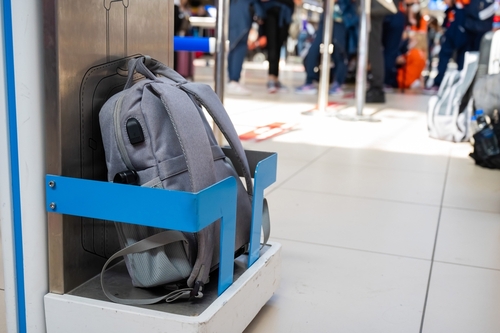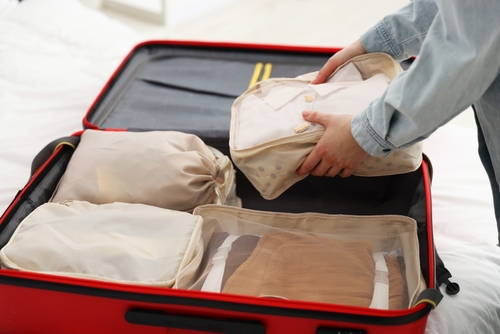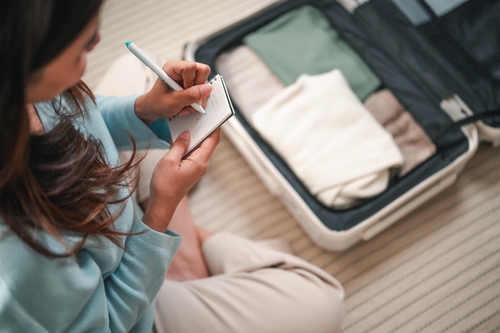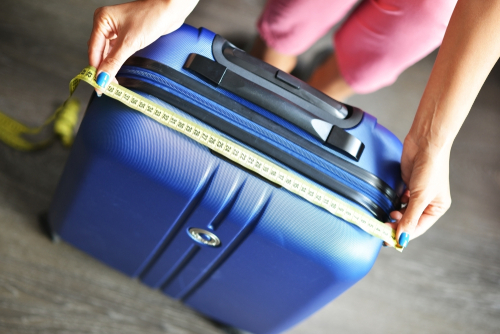You’ve made it through check-in, breezed past security, and finally reached your gate only to hear the phrase every traveler fears: “That bag’s too big.”
If you’re new to flying in the US, you’re not alone in feeling confused. Every airline seems to play by its own rules. Some are relaxed, others strict—and suddenly, you’re wondering if your trusty suitcase from home even counts as a carry-on here.
At Remitly, we understand what it’s like to adjust to new systems and expectations. Many of us have been in your shoes—standing in front of an airline’s luggage-sizer box and silently praying our bag fits. That’s why we’ve put together this guide to make your travel a little less stressful.
What is the standard size for carry-on luggage?
For most US airlines, the standard carry-on size is 22 x 14 x 9 inches (56 x 36 x 23 cm)—including wheels and handles. But not every airline follows it exactly. Smaller planes, especially on short routes, have tighter overhead bins, and budget airlines often use slightly smaller measurements to encourage passengers to check their bags before arriving at the airport.
If you’ve ever traveled internationally, you might also notice that carry-on limits in the US tend to be a bit different in size and less strict on weight. It’s the opposite of many international airlines, which often weigh your carry-on before you board.

Airline carry-on luggage size guide
If there’s one thing that’s important for all travelers to know, it’s that every airline is different. So, whatever is “carry-on approved” for Delta might not pass for another airline, such as Air Canada.
| Airline | Carry-on dimensions (inches) | Personal item (inches) | Weight limit (pounds) |
Notes |
| American Airlines | 22 x 14 x 9 | 18 x 14 x 8 | None | Includes wheels and handles |
| Delta Air Lines | 22 x 14 x 9 | 18 x 14 x 8 | None | No strict weight rule |
| United Airlines | 22 x 14 x 9 | 17 x 10 x 9 | None | Basic Economy = personal item only |
| Southwest Airlines | 24 x 16 x 10 | 16.25 x 13.5 x 8 | None | Most generous size in the US |
| Alaska Airlines | 22 x 14 x 9 | 17 x 11 x 9 | None | Includes wheels and handles |
| JetBlue | 22 x 14 x 9 | 17 x 13 x 8 | None | Blue Basic = personal item only |
| Spirit Airlines | 22 x 18 x 10 (paid) | 18 x 14 x 8 (free) | 40 | Strict enforcement |
| Frontier Airlines | 24 x 16 x 10 (paid) | 18 x 14 x 8 (free) | 35 | Charges for carry-ons |
| British Airways | 22 x 18 x 10 | 16 x 12 x 6 | 51 | International flights |
| Air Canada | 21.5 x 15.5 x 9 | 17 x 13 x 6 | 22 | Slightly smaller |
| Emirates | 22 x 15 x 8 | 15 x 11 x 6 | 15 | Strict weight limits |
Why budget airlines have different rules
Budget airlines operate differently from traditional carriers. They keep ticket prices low by charging separately for extras like carry-on bags, seat selection, and even snacks. But this model also means they’re often stricter about bag sizes.
Even if your suitcase looks compact, it might need to fit exactly into a metal luggage-sizer at the gate—and if it doesn’t, you may be required to check it for an added fee.
Carry-on rules for newcomers flying in the US
If you’ve just started flying within the US, you might notice a few differences compared to international travel—especially when it comes to airport security.
TSA’s famous 3-1-1 rule for liquids
The Transportation Security Administration (TSA) establishes airport security rules nationwide. One of the most important ones to remember is the 3-1-1 rule for liquids, including items like lotion, toothpaste, and even hair gel:
- 3.4 ounces (100 ml) or less per container
- All bottles must fit in one quart-sized clear bag
- One bag per passenger
If you travel often, it may be worth signing up for TSA PreCheck. This program allows you to skip some of the usual screening steps—like removing shoes, belts, or laptops—and enjoy shorter lines at security. Once you’ve used it, it’s hard to go back.
The reality of Basic Economy
Some low-cost fares—especially with airlines like United or JetBlue—don’t include a carry-on bag. In these cases, you’re only allowed one small personal item that fits under the seat in front of you.
Once you learn how each airline defines “carry-on,” it quickly becomes second nature. I found out the hard way when my usual suitcase was tagged at the gate for an unexpected fee. Now, I always double-check the fine print before booking.

How to prepare your carry-on
Before you start packing, take a few minutes to double-check that your bag meets airline size limits.
Measuring your carry-on correctly
Set your suitcase upright and measure from the floor to the top of the handle when retracted. Then measure across the front (widest part), and front-to-back—including wheels and handles.
Even being half an inch over can cause problems at the gate. A small luggage tape measure or travel scale is worth keeping on hand, especially if you fly often. It takes the guesswork out of packing.
What actually fits inside a carry-on
You’d be surprised how much a carry-on can hold. With smart packing, a week’s worth of clothes is totally doable. Most travelers can fit:
- A couple of pairs of pants
- A few shirts or tops
- A light sweater or jacket
- One pair of shoes
- Toiletries and essentials
Rolling your clothes instead of folding helps save space and reduces wrinkles.
If you’re flying home to see family or traveling between states, focus on mix-and-match pieces. Lightweight fabrics and neutral colors go a long way. And to free up space, wear your bulkiest items—like sneakers or a jacket—on the plane.

Smart packing tips for stress-free travel
Packing is part art, part survival skill—especially if you have a tight connection or a long layover. A few smart habits can make your travel day smoother and less stressful.
Preparing for TSA
Airport security might never be the highlight of your trip, but it doesn’t have to be a headache. Keep liquids and electronics near the top of your bag so they’re easy to remove at screening. And skip wrapping gifts—TSA may need to open them, and no one wants to rewrap at the gate.
Comfort matters, too. Slip-on shoes, soft layers, and minimal metal accessories will help you breeze through checkpoints. TSA agents assist travelers every day, so don’t hesitate to ask questions if you’re unsure about what’s allowed.
Keeping essentials handy
Experienced travelers know the value of having key items within reach. Keep your passport, ID, phone charger, medication, and travel documents in a spot you can access easily—like a small crossbody bag or belt pouch.
A few comfort items go a long way, too. Pack a refillable water bottle, a snack, and maybe a travel pillow for long layovers. If you’ve ever been hungry mid-flight with no options in sight, you know: a granola bar can feel like gold.
Staying organized on the go
After a few days on the road, your carry-on can start to feel chaotic. Take a minute each night to repack, so your essentials stay easy to reach and your final travel day goes more smoothly. If your flight is delayed, you’ll be glad you did—you’ll be able to grab your toothbrush, headphones, or a clean shirt without digging through everything at the airport.
Sustainable and minimalist travel tips
Traveling light isn’t just convenient—it’s also better for the planet. Reusable water bottles, solid shampoo bars, and compact toiletry kits reduce waste while making TSA screening quicker, too.
A great option is to try a capsule wardrobe: a few versatile, mix-and-match pieces that keep your outfits simple but polished. You’ll pack less, carry lighter, and spend less time deciding what to wear.
If you’re buying new luggage, look into sustainable brands that use recycled materials and offer repair programs. And remember: the lighter your bag, the less fuel the plane uses overall. Small, mindful choices make a difference—especially when millions of travelers are making them together.

Choosing the right luggage
The perfect carry-on isn’t just about size—it’s about how you travel.
Finding the right carry-on for your needs
If you prefer flexibility, go for a soft-shell bag. They’re more forgiving in tight overhead bins. Hard-shell cases offer better protection for electronics and souvenirs, but they don’t flex as easily when space is limited.
If you fly often, durability matters more than style. Look for spinner wheels, sturdy zippers, and a solid handle. Brands like Travelpro (a favorite of flight crews) are known for reliability, while Away and Monos offer sleek designs and lifetime warranties.
How to avoid luggage fees
Many airlines charge less if you prepay for bags online—paying at the airport is usually more expensive. In some cases, upgrading from Basic Economy to a regular fare costs less than paying for a carry-on separately.
And if you’re great at packing light, you might be able to skip the carry-on fee entirely by traveling with just a personal item—like a small backpack or duffel that fits under the seat.
Traveling with kids or family
Flying with little ones can be a challenge—but it’s absolutely doable. Most airlines allow parents to bring diaper bags and strollers for free, and families with young children typically board early.
Giving each child a small backpack with snacks and activities keeps them entertained—and gives you a bit of breathing room. If your kids are old enough, let them help with packing! It teaches independence and avoids the urge to overpack “just in case.”
Flying internationally to visit family? Be sure to check baggage limits if you plan to bring gifts.

Travel with confidence
Travel can feel unpredictable—especially in a new country. But with the right information and a little preparation, every trip becomes smoother and less stressful.
Whether you’re catching your first flight in the US, heading home to see loved ones, or exploring somewhere new, knowing your carry-on luggage size helps everything go more smoothly.
At Remitly, we’re here to help make life abroad easier—from managing your money to helping you feel confident, wherever you go.
FAQs
What happens if my carry-on is too big?
If your bag doesn’t fit in the airline’s sizer, you’ll likely need to check it—and pay an extra fee, especially if you’re at the gate.
What’s the difference between a carry-on and a personal item?
A carry-on goes in the overhead bin, while a personal item—like a small backpack or handbag—must fit under the seat in front of you.
Does a backpack count as a carry-on?
It depends on the size. Smaller backpacks usually count as personal items. Larger ones are often considered carry-ons.
Do wheels and handles count in measurements?
Yes—always include wheels, handles, and any outer pockets when measuring your carry-on.
Is there a weight limit for carry-ons?
Most US airlines don’t have weight limits for carry-ons, but international and budget airlines often do—typically between 15–22 lbs (7–10 kg).

